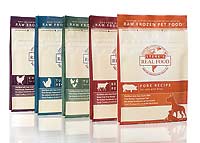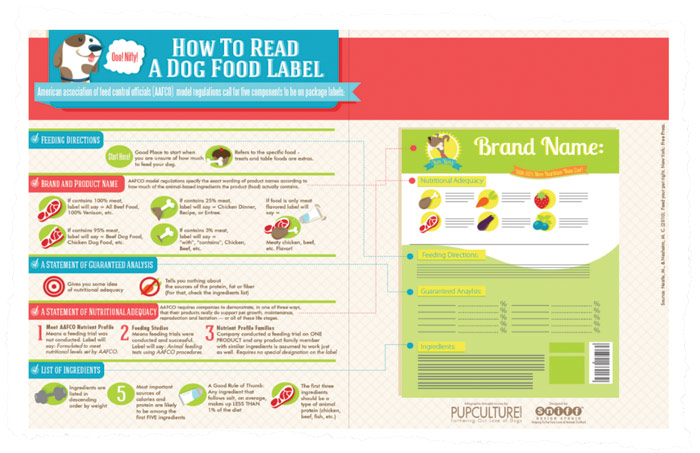Understanding the label of a pet food is very important, as it is a legally binding contract between you and the pet food manufacturer. Even pet nutritionists have problems at times decoding pet food labels. There are thousands of things to consider, from maximums and minimums of fiber content to ingredient sourcing to how the food was actually tested so you don’t inadvertently turn your pets into test animals. Here is a simple way to decode the pet food label and to make the most of the information you’re given.
Labels, and any claims made on them, are regulated both on a federal and a state level. The federal regulations are published in the Code of Federal Regulations (CFR), Title 21CFR. Every label is required by law to have eight pieces of information. Three things must be on the front of the package in plain view.
Brand and Product Name: The name of the food will actually indicate the percentage of protein in the food.
Species: The species the food is formulated for.
Quantity: The weight of food in the bag, can, roll or container.
The other five items may be included on the front label or elsewhere on the package, such as on a back or side label (called the “information panel”).
Guaranteed Analysis: Typically, the minimum percentages of crude protein and crude fat, and the maximum percentages of crude fiber and moisture (crude refers to testing not the food).
Ingredient Statement: All ingredients are listed in order of predominance by weight, including their inherent water content.
Nutritional Adequacy Statement: A substantiated claim of the food’s nutritional adequacy (e.g., complete and balanced) as well as which life stage(s) it is for.
Feeding Directions: Recommended quantity based on weight and/or age of pet.
Contact Information: Name and address of manufacturer or distributor.
The name of a pet food indicates the percentage of protein it has in it. If the food’s name includes a type of protein, then it must contain 95% by weight of that protein. For example, Beef Dog Food is 95% beef. Foods named “dinner, entree, platter or formula” must contain at least 25% of the stated protein (and up to 75% of other ingredients). Food names that include the words “with or contains” must consist of only 3% of the stated protein (and contain 97% of other ingredients). Foods described as “flavor” have no requirements on the amount of protein they must contain and may not include any of the stated protein at all.
Commercial diets and treats are legally required to include proper listing of all the ingredients in the product in order from most to least, based on weight. “Ingredients must be listed in order of predominance by weight, on an ‘as formulated’ basis,” according to the Association of American Feed Control (AAFCO), a voluntary membership association of local, state and federal agencies charged by law to regulate the sale and distribution of animal feeds (including pet foods) and animal drug remedies. The ingredient that makes up the highest percentage of the total weight as it goes into the product is listed first. Each ingredient must be listed by its appropriate name.
There are hundreds of meaningless marketing terms on dog food labels and we’ve listed just a few here. These words are just words, they have no legal definition (which is why you’ll see a lot of them) and there are no legal requirements for including them on packaging. When you see them, take the info with a grain of salt.
Natural: Arsenic is also natural. So are water, chicken, and the highest grade of protein. The US Food and Drug Administration (FDA) states, “The term ‘natural’ is often used on pet food labels, although that term does not have an official definition.” While the FDA does not have an official meaning, AAFCO does. It states, “For the most part, ‘natural’ can be construed as equivalent to a lack of artificial flavors, artificial colors, or artificial preservatives in the product.”
Holistic: The actual meaning of holistic is “characterized by comprehension of the parts of something as intimately interconnected and explicable only by reference to the whole.” It means nothing.
Premium: FDA labeling guidelines state that, “Products labeled as premium or gourmet are not required to contain any different or higher quality ingredients, nor are they held up to any higher nutritional standards than are any other complete and balanced products.”
Made in the USA: The Federal Trade Commission (FTC) governs this aspect of labeling. The rule states that “all or virtually all means” all significant parts and processing that go into the product must be of U.S. origin. That is, the product should contain no—or negligible—foreign content.
Organic: The organic seal is tricky to understand and it makes a difference where you find it on the label. “Organic” refers to the handling and processing of ingredients and products, not necessarily the quality of the product. If the official USDA Organic seal is on the actual label, then that means all ingredients are organic. If the seal is on the food ingredient panel, that means the food has less than 70% organic ingredients. If the statement says, “Made with Organic Ingredients” then 70 to 94% of the product is organic. The seal is allowed to be used anywhere on packaging if less than 70% of the products are non-organic. Pet foods and pet treats must comply with the USDA’s National Organic Program (NOP) regulations (7 CFR 205). These regulations cover ingredient sourcing, ingredient handling, manufacturing, labeling and certification of products wanting to use the word “organic” in their labeling. Organic only refers to the processing of a product, not the quality of the product.
Human grade: For a product to be human grade, all ingredients in the product must be human edible and the product must be manufactured, packed and held in a plant approved for manufacturing human food. However, this regulation doesn’t apply to advertising and websites, so some pet food companies will advertise “human grade” ingredients in their products.
As you can see, choosing a pet food involves more than buying a bag with the most compelling image. Once you’re aware of the legal guidelines behind pet food labels, and have researched various pet food manufacturers you’ll be better equipped to select the best products for your pets.

|